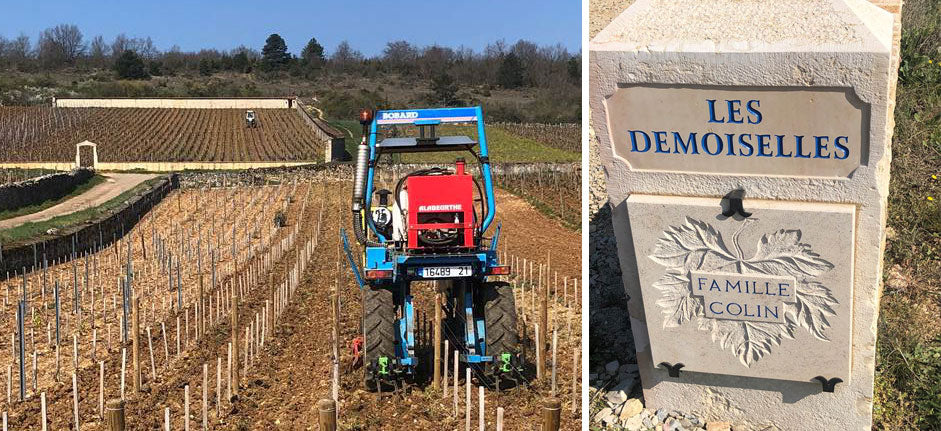
Spring and budding in the vineyards are always an exciting time for vignerons, but it can be accompanied by an equal amount of stress, namely the fear of frost. Two days after I posted my blog on the 25th March, temperatures dropped and there was a sharp frost the morning of Friday 27th. Nathalie Tollot from Domaine Tollot-Beaut commented that for them it was too early to impact their Pinot Noir vines in Savigny Lès Beaune: “the vines are still in the very early stages of budding and not sufficiently advanced for the frost to have any impact”. A worry though for all growers in Burgundy is that with the new Covid-19 restrictions the authorisation of straw fires and the scenes of early morning smoke across the vineyards to act as a protector against frost has been prohibited this year for health and practical reasons. This means the vignerons have one less piece of ammunition in their armoury to fight a harsh spring frost in 2020. For the white vineyards of the Côte d’Or, the concern of frost has been slightly greater as the Chardonnay is always a week to ten days in advance of Pinot in its development. Jean-Philippe Fichet in Meursault expressed his worries, but with it sent some amazing photos of the growers’ attempts to combat the frost this year with the use of lanterns (arial picture by Vincent Dancer, Chassagne Montrachet). Whilst a magnificent sight for the amateur photographers amongst us, it isn’t something we would wish to see regularly as wine lovers. Fortunately, their worries were unfounded and today we can report there has been no significant loss of potential fruit so far.

The news is much the same in Bordeaux. An area that always seems to be particularly vulnerable at this time of year is Pessac-Léognan. Véronique Sanders of Ch Haut-Bailly said that whilst reporting a sharp drop in temperature in this same period, the effects have not been too damaging. Similarly, in the Loire Valley, Bernard Reverdy gives a lovely positive slant: “this cooler weather is great, it just slows things down a bit which is just what I want at this stage”.
Beyond the worries of the weather and nature, spring also represents the start of a new era and generation. How often have I heard in answer to my question, “How old are these vines?”, a response such as “ Ah, my parents planted that parcel of Richebourg the year they got married in…” or “Ah, this is really special to me, my grandfather planted that parcel the year I was born”, as is the case for Sylvain Cathiard and the Domaine’s Nuits St Georges Aux Thorey, planted in 1953. Similarly, I can always remember the year in which Jean-Marie Fourrier’s Gevrey Chambertin Vieilles Vignes were planted: “It was 1928 as it was my father’s birth year and, like the vineyard, he is still so full of life”. March and April are the time for replanting new vineyards and many of my recent conversations with our vigneron friends have involved them excitedly telling me about their new planting programmes. Mathilde Grivot is planting their Chambolle Musigny Combe d’Orveau, Nathalie Tollot their Savigny vineyards and these wonderful photos of Bruno Colin replanting their famous Puligny Montrachet 1er Cru Demoiselles plot, running alongside the great Le Montrachet and sitting just below Chevalier Montrachet. These vineyards and their plantings will be remembered for many years to come and I truly hope that 2020 will be remembered with some positivity. What is certain is that these vines will breed new life and give huge pleasure to future generations of wine lovers.

These past few days have seen a shift in temperature. France like us enjoyed glorious weather over the Easter weekend. Whilst the risk of frost remains until the end of the month, the attitude is positive, and the vineyards will hopefully be set nicely for a healthy flowering in May. Inside the cellars, March and April are always particularly busy months due to bottling commitments for estates that specialise in making wines to be drunk the year after harvest, such as many whites from the Loire valley, the white and red wines of the Mâconnais and, hugely important as we start to think of our summer drinking plans, the lovely youthful, vibrant rosés from Provence and other southerly wine producing regions. Similarly, these two months are a crucial bottling period for regions such as Bordeaux, Burgundy and the Rhône, whose wines go through 14-18 months maturation in cask and are now in the process of being bottled. The 2018 vintage from these regions is now being bottled in anticipation of shipment later in the year.
Happily, we are in constant contact with all our growers, we all share a passion for wine and whilst we miss our vineyard visits and travel, the constant flow of photos and video calls shows that their spirits are high and the vineyards throughout Europe look extremely healthy. We all welcome the day when we can share a lovely glass again together.

